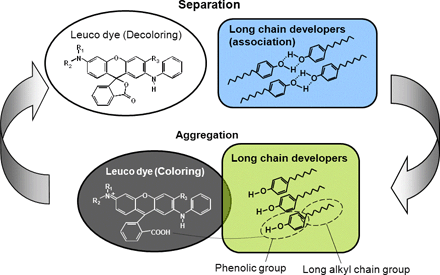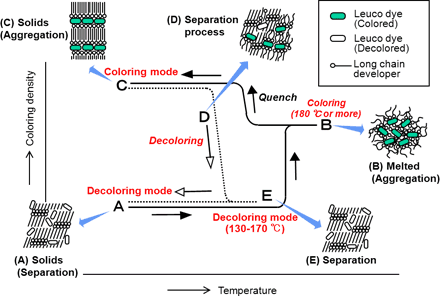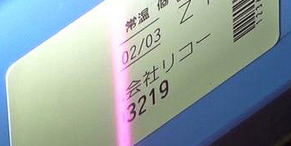- Home
- Ricoh's Technology
- Rewritable Recording Technology
Rewritable Recording Technology
Rewritable recording?
What is rewritable recording? It is defined by the academic journal of Soc. of Electrophotography of Japan (Vol.34, No.4 (1995), p.441) as “A rewritable marking technology is a technology to form a visible image, by giving energies, such as heat, light, magnetism, electrical field, and/or pressure, where the image is maintained without giving any energy, and when an energy is given again, the image is deleted to allow its repetition.”
Rewritable recording likely began with the desire to be able to erase written images easily. For several decades, chromic materials have been considered to show color transition; materials include photochromic material and thermo-chromic material. Colors changing and images disappearing is what fascinates people who work with these more than anything else. Applications have been proposed that reduce the environmental impact of copy paper by using it repeatedly instead of disposing of it, as well as for displaying and visualizing part of the information stored in magnetic and IC devices.
Currently, the primary use of rewritable recording is card display, where a portion of the information stored in magnetic, IC, or other memory is displayed on the card. A common example of this is a point card that displays the accumulated points that are awarded based on the purchase price of a product, or a commuter pass that displays the expiration date. Further, the application is being expanded to industrial use by combining it with RF-ID or laser recording. Thermal rewritable recording materials using heat for rewrite energy are mainly used for these applications.
Characteristics of the leuco dye/long-chain developer type thermal rewritable recording material, a typical rewritable recording material, and their coloring and decoloring mechanisms are explained below.
Characteristics of rewritable recording material and coloring and decoloring mechanisms
Thermal rewritable recording materials (the combination of leuco dye with a developer having a long-chain alkyl group) feature arbitrary coloring, such as black, blue, and red, depending on the kind of leuco dye. The developer molecule, having a long-chain alkyl group, can extract developer from the leuco dye using the crystallization energy of the developer itself, and can control the coloring and decoloring modes. The coloring and decoloring modes are controlled by aggregation and separarion leuco dye and a long-chain type developer by heating, as shown in Fig. 1.
 Fig. 1: Coloring and decoloring control by aggregation and separarion of leuco dye and long-chain type developer
Fig. 1: Coloring and decoloring control by aggregation and separarion of leuco dye and long-chain type developer
The typical coloring and decoloring process of leuco dye/long-chain developer type thermal rewritable recording material and the mechanism of coloring/decoloring phenomenon are shown in Fig. 2. When a developer is heated from a decoloring mode (A) beyond the melting point, it melts and reacts with the leuco dye; color develops (B). When is quenched from here, the developer clumps together with regularity while maintaining a bond with the leuco dye and a coloring mode is fixed (C). When the temperature rises from coloring mode (C), this condensed state begins to collapse at a temperature lower than coloring temperature (D). When the temperature rises further, the developer associates (the phenomenon of two same kind molecules joining together and acting as one molecule), builds a crystal independently, and sputters out leuco dye to decolor (E). When cooled from this state, it returns to the original decolored state (A). The developer stays in the crystallized state at (A), which is the most stable state.
 Fig. 2: Coloring and decoloring mechanism
Fig. 2: Coloring and decoloring mechanism
Challenges to improving speed, stability, light-fastness, and durability
Some issues must be solved to put the leuco dye/long-chain developer type thermal rewritable recording material into practical use. Ricoh has approached these technical issues as follows:
(1) Strike a balance between shortening decoloring time and coloring stability
To improve stability of the coloring mode, reactivity of the leuco dye and developer must be improved. Beyond that, leuco dye from the developer must be separated promptly to decolor quickly. To reconcile these, Ricoh achieved both qualities by creating a new material, compounding a long-chain type developer.
(2) Improve light-fastness
Although leuco dye is also used for the thermal paper commonly used for receipts and the like, being heated and printed, yellowing and browning of the backgrounds and images occurs. This happens because leuco dye is naturally weak to light. It is especially important for rewritable recording material to be used longer to prevent this discoloration. In addition, the formed images remain thin even if erasure is tried. This phenomenon is peculiar to rewritable recording materials, but the degradation is based on ultraviolet rays and oxygen.
Ricoh improved light-fastness to a practical level for card applications by placing a layer containing ultraviolet absorbers above the recording layer to block ultraviolet rays. Further, we improved light-fastness by dozens of magnitude over the past by compounding a new material and preparing a new oxygen interception layer to block ultraviolet rays until just before visible light for application expansion in an outdoor environment, such as for physical distribution. This technology is used for the rewritable laser system.
(3) Improve repetitive durability
To improve practicality by taking advantage of the “rewritable” feature, durability of the recording medium itself must be improved. Ricoh improved durability of the recording layer itself by forming cross-links in matrix resins holding leuco dye and the long-chain type developer, which comprise the main material of a recording layer (to make a 3D network by bridge bonding high molecules). Moreover, we changed the recording process from the conventional thermal print-head to a laser, deleting physical loads, such as pressure on the media by a thermal print-head. Further, controlling laser scanning to uniform heating improved repetitive durability to 1,000 times. Such technical developments have made it possible for Ricoh to achieve a highly efficient rewritable recording system heretofore not possible.
Rewritable recording process technology
Images are formed when the heat is spread quickly around and cooled rapidly, after a recording layer is heated momentarily with small energy using a thermal print-head or laser. Because decoloring is seldom influenced by cooling speed, heating must be done in a fixed temperature range where decoloring is possible although deletion of the image is possible using various heating systems. With the complex RF-ID tag media (Fig. 3), decoloring of images is achieved with big heating areas such as heat roller or ceramic heater.
 Fig. 3: RF tag media and printer
Fig. 3: RF tag media and printer
The rewritable laser system erases images by irradiating the circular beam two-dimensionally, as shown in Figure 4. We shorten the erasing time and prevent the folded part from overheating by running N-shaped reciprocating scans continuously. Figure 5 shows how it is erased. Since the irradiation laser is invisible light, it is not possible to visually confirm the trajectory of the light.
 Fig. 4: Image of laser scanning method
Fig. 4: Image of laser scanning method
 Fig. 5: Erasing with Ricoh rewritable laser system (laser is invisible light)
Fig. 5: Erasing with Ricoh rewritable laser system (laser is invisible light)
Extending applications
Ricoh's rewritable recording technology was first put into practical use for card displays, such as point cards, commuter passes, etc., where the display needs to be rewritten. RECO-View RF tags were then commercialized, combined with RF-ID used for production control etc., further expanding the application to a rewritable laser system where the media for a physical distribution application affixed on returnable containers can be rewritten with no contact.
Sorted by : field “Thermal Media” “Resource Conservation” | product type “Thermal Media” “Environment”
- Technology and Market of Thermal Rewritable Marking (PDF:701KB)(Source: Journal of the Imaging Society of Japan, Vol.50, No.2, pp.154-159, 2011, ©The Imaging Society of Japan)
(The paper is posted with permission from the Imaging Society of Japan.)
